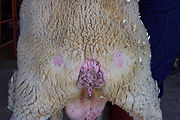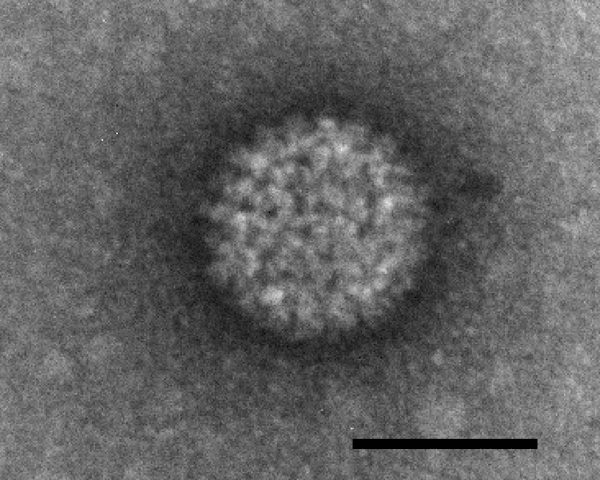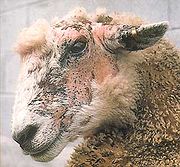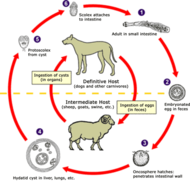
List of infectious sheep and goat diseases
Encyclopedia

Ruminant
A ruminant is a mammal of the order Artiodactyla that digests plant-based food by initially softening it within the animal's first compartment of the stomach, principally through bacterial actions, then regurgitating the semi-digested mass, now known as cud, and chewing it again...
s with cosmopolitan distribution
Cosmopolitan distribution
In biogeography, a taxon is said to have a cosmopolitan distribution if its range extends across all or most of the world in appropriate habitats. For instance, the killer whale has a cosmopolitan distribution, extending over most of the world's oceans. Other examples include humans, the lichen...
s due to their being kept historically and in modern times as grazers both individually and in herds in return for their production of milk
Milk
Milk is a white liquid produced by the mammary glands of mammals. It is the primary source of nutrition for young mammals before they are able to digest other types of food. Early-lactation milk contains colostrum, which carries the mother's antibodies to the baby and can reduce the risk of many...
, wool
Wool
Wool is the textile fiber obtained from sheep and certain other animals, including cashmere from goats, mohair from goats, qiviut from muskoxen, vicuña, alpaca, camel from animals in the camel family, and angora from rabbits....
, and meat
Meat
Meat is animal flesh that is used as food. Most often, this means the skeletal muscle and associated fat and other tissues, but it may also describe other edible tissues such as organs and offal...
. As such the diseases of these animals are of great economic importance to humans.
- PrionPrionA prion is an infectious agent composed of protein in a misfolded form. This is in contrast to all other known infectious agents which must contain nucleic acids . The word prion, coined in 1982 by Stanley B. Prusiner, is a portmanteau derived from the words protein and infection...
s: scrapieScrapieScrapie is a fatal, degenerative disease that affects the nervous systems of sheep and goats. It is one of several transmissible spongiform encephalopathies , which are related to bovine spongiform encephalopathy and chronic wasting disease of deer. Like other spongiform encephalopathies, scrapie...

- VirusVirusA virus is a small infectious agent that can replicate only inside the living cells of organisms. Viruses infect all types of organisms, from animals and plants to bacteria and archaea...
es: foot-and-mouth diseaseFoot-and-mouth diseaseFoot-and-mouth disease or hoof-and-mouth disease is an infectious and sometimes fatal viral disease that affects cloven-hoofed animals, including domestic and wild bovids...
, bluetongue diseaseBluetongue diseaseBluetongue disease or catarrhal fever is a non-contagious, non-zoonotic, insect-borne, viral disease of ruminants, mainly sheep and less frequently cattle, goats, buffalo, deer, dromedaries and antelope...
, maedi-visna, orfOrf (disease)Orf is an exanthemous disease caused by a parapox virus and occurring primarily in sheep and goats. It is also known as contagious pustular dermatitis, infectious labial dermatitis, ecthyma contagiosum, and sheep pox, thistle disease and scabby mouth...
, tick-borne encephalomyelitis, peste-des-petits-ruminants virusPeste-des-petits-ruminants virusOvine rinderpest, also commonly known as peste des petits ruminants , is a contagious disease affecting goats and sheep in Africa , the Middle-East and the Indian subcontinent. But since June 2008, the disease invaded Morocco , which indicates a crossing of the natural barrier of the Sahara...
, sheeppox and goatpox
- BacteriaBacteriaBacteria are a large domain of prokaryotic microorganisms. Typically a few micrometres in length, bacteria have a wide range of shapes, ranging from spheres to rods and spirals...
: blacklegBlackleg (disease)Blackleg, black quarter, quarter evil, quarter ill is an infectious bacterial disease of sheep and cattle, caused by Clostridium chauvoei bacteria. It is found all over the world. A symptom of blackleg is characteristic swellings which make a cracking sound under pressure...
, foot rotFoot rotFoot rot, or infectious pododermatitis, is a hoof infection commonly found in sheep, goats, and cattle. As the name suggests, it rots away the foot of the animal, more specifically the area between the two toes of the affected animal. It is extremely painful and contagious. It can be treated with...
, caprine pleuropneumonia, contagious bovine pleuropneumoniaContagious bovine pleuropneumoniaContagious bovine pleuropneumonia , is a contagious bacterial disease that afflicts the lungs of cattle, buffalo, zebu, and yaks....
, chlamydiosisChlamydophila abortusChlamydophila abortus is a species in Chlamydiae that causes abortion and fetal death in mammals, including humans. Chlamydophila abortus was previously classified as Chlamydia psittaci along with all Chlamydiae except Chlamydia trachomatis. This was based on a lack of evident glycogen production...
, Johne's diseaseJohne's diseaseParatuberculosis or Johne's disease is a contagious, chronic and sometimes fatal infection that primarily affects the small intestine of ruminants. It is caused by the bacterium Mycobacterium avium subspecies paratuberculosis...
, listeriosis, fleece-rot

- FungusFungusA fungus is a member of a large group of eukaryotic organisms that includes microorganisms such as yeasts and molds , as well as the more familiar mushrooms. These organisms are classified as a kingdom, Fungi, which is separate from plants, animals, and bacteria...
es: Facial eczemaFacial eczemaFacial eczema, FE, is a disease that mainly affects ruminants such as cattle, sheep, deer, goats and South American camelids ....
- Parasites:
- protozoaProtozoaProtozoa are a diverse group of single-cells eukaryotic organisms, many of which are motile. Throughout history, protozoa have been defined as single-cell protists with animal-like behavior, e.g., movement...
: TrypanosomaTrypanosomaTrypanosoma is a genus of kinetoplastids , a monophyletic group of unicellular parasitic flagellate protozoa. The name is derived from the Greek trypano and soma because of their corkscrew-like motion. All trypanosomes are heteroxenous and are transmitted via a vector...
spp., BabesiaBabesiaBabesia is a protozoan parasite of the blood that causes a hemolytic disease known as Babesiosis. There are over 100 species of Babesia identified; however only a handful have been documented as pathogenic in humans....
spp., Theileria hirci, Anaplasma ovis, EimeriaEimeriaEimeria is a genus of Apicomplexan parasites that includes various species responsible for the poultry disease coccidiosis. The genus is named for the German zoologist Theodor Eimer...
spp., Toxoplasma gondiiToxoplasma gondiiToxoplasma gondii is a species of parasitic protozoa in the genus Toxoplasma. The definitive host of T. gondii is the cat, but the parasite can be carried by many warm-blooded animals . Toxoplasmosis, the disease of which T...
, Giardia intestinalisGiardia lambliaGiardia lamblia is a flagellated protozoan parasite that colonizes and reproduces in the small intestine, causing giardiasis. The giardia parasite attaches to the epithelium by a ventral adhesive disc, and reproduces via binary fission...
, SarcocystisSarcocystisSarcocystis is a genus of protozoa. Species in this genus infect reptiles, birds and mammals. The name is dervived from Greek: sarx = flesh and kystis = bladder.There are about 130 recognised species in this genus...
spp., Cryptosporidium parvumCryptosporidium parvumCryptosporidium parvum is one of several protozoal species that cause cryptosporidiosis, a parasitic disease of the mammalian intestinal tract....
, Ehrlichia ovina
- protozoa

-
- helminths:
- flatworms: Fasciola hepaticaFasciola hepaticaFasciola hepatica, also known as the common liver fluke or sheep liver fluke, is a parasitic flatworm of the class Trematoda, phylum Platyhelminthes that infects the livers of various mammals, including humans. The disease caused by the fluke is called fascioliasis . F...
, Fasciola giganticaFasciola giganticaFasciola gigantica is a parasitic flatworm of the class Trematoda, which causes tropical fascioliasis. It is regarded as one of the most important single platyhelminth infections of ruminants in Asia and Africa...
, Fascioloides magnaFascioloides magnaFascioloides magna, also known as giant liver fluke, large American liver fluke or deer fluke, is an important parasite of a variety of wild and domestic ruminants in North America and Europe. Adult flukes occur in the liver of the definitive host and feed on blood...
, Dicrocoelium dendriticumDicrocoelium dendriticumThe Lancet liver fluke is a parasite fluke that tends to live in cattle or other grazing mammals.- History of discovery :...
, Schistosoma bovis - tapeworms: Echinococcus granulosusEchinococcus granulosusEchinococcus granulosus, also called the Hydatid worm or Hyper Tape-worm, is a cyclophyllid cestode that parasitizes the small intestine of canids as an adult, but which has important intermediate hosts such as livestock and humans, where it causes hydatid disease...
, Taenia ovis, Taenia hydatigena, MonieziaMonieziaMoniezia a genus of tapeworms that are parasitic in mammals, including sheep, goat and cattle. It comprises four known species such as M. expansa, M. benedeni, M. autumnalis and M. baeri. M. expansa is the most well known species within the genus because of its high prevalence. Members of the genus...
spp. - roundworms: (including Hoose (disease)Hoose (disease)Hoose is a disease of sheep, cattle, goats, and swine caused by the presence of various species of nematodes of the genera Dictyocaulus, Metastrongylus, and Protostrongylus in the bronchial tubes or in the lungs. It is marked by cough, dyspnea, anorexia and constipation. Also called verminous...
) Elaeophora schneideriElaeophora schneideriElaeophora schneideri is a nematode which infests several mammalian hosts in North America. It is transmitted by horse-flies. Infection in the normal definitive hosts, Mule deer or Black-tailed deer, seldom produces clinical symptoms...
, Haemonchus contortusHaemonchus contortusHaemonchus contortus, also known as red stomach worm, wire worm or Barber's pole worm, is very common parasite and one the most pathogenic nematode of ruminants. Adult worms are attached to abomasal mucosa and feed on the blood...
, TrichostrongylusTrichostrongylusTrichostrongylus species are nematodes , which are ubiquitous among herbivores worldwide, including cattle, sheep, donkeys, goats, deer, and rabbits ....
spp., Teladorsagia spp., Cooperia spp., Nematodirus spp., Dictyocaulus filaria, Protostrongylus refescens, Muellerius capillarisMuellerius capillarisMuellerius capillaris , also known as hair lungworm, is nematode parasite of small ruminants. Adult worms occur in small air passages and in the alveoli, even in the subpleural tissue. In ruminants, parasite causes chronic bronchopneumonia. In case of massive infection or secondary bacterial...
, OesophagostomumOesophagostomumOesophagostomum species are free-living nematodes of the family Strongyloidae. These worms occur in Africa, Brazil, China, Indonesia and the Philippines. The majority of human infection with Oesophagostomum is localized to northern Togo and Ghana...
spp., Neostrongylus linearis, Chabertia ovina, Trichuris ovis
- flatworms: Fasciola hepatica
- arachnidArachnidArachnids are a class of joint-legged invertebrate animals in the subphylum Chelicerata. All arachnids have eight legs, although in some species the front pair may convert to a sensory function. The term is derived from the Greek words , meaning "spider".Almost all extant arachnids are terrestrial...
s and insectInsectInsects are a class of living creatures within the arthropods that have a chitinous exoskeleton, a three-part body , three pairs of jointed legs, compound eyes, and two antennae...
s:- ticks: IxodesIxodesIxodes is a genus of hard-bodied ticks . It includes important disease vectors of animals and humans . Some ticks in this genus may transmit the pathogenic bacterium Borrelia burgdorferi responsible for causing Lyme disease...
spp., AmblyommaAmblyommaAmblyomma is a genus of hard ticks. Some are disease vectors, for example for Rocky Mountain spotted fever in Brazil or ehrlichiosis and anaplasmosis in the USA....
spp., Boophilus spp., DermacentorDermacentorDermacentor is a genus of hard-bodied ticks.-Species:* Dermacentor abaensis Teng, 1963* Dermacentor albipictus Packard, 1869* Dermacentor andersoni Stiles 1908* Dermacentor asper Arthur, 1960...
spp., Haemphysalis spp., HyalommaHyalommaHyalomma is a genus of hard-bodied ticks, common in Asia, Europe, and Hyalomma is a genus of hard-bodied [[tick]]s, common in [[Asia]], [[Europe]], and...
spp., RhipicephalusRhipicephalusRhipicephalus is a genus of tick.-Species:* Rhipicephalus annulatus Say, 1821* Rhipicephalus appendiculatus Neumann 1901* Rhipicephalus aquatilis Walker, Keirans & Pegram, 1993* Rhipicephalus armatus Pocock, 1900...
spp. - mites: Psoroptes ovis, Sarcoptes ovis, Chorioptes ovis, Demodex ovis, Demodex caprae
- lice: Lepikentron ovis, Bovicola caprae, Linognathus ovillus, Linognathus stenopsis
- DipteraDipteraDiptera , or true flies, is the order of insects possessing only a single pair of wings on the mesothorax; the metathorax bears a pair of drumstick like structures called the halteres, the remnants of the hind wings. It is a large order, containing an estimated 240,000 species, although under half...
: AnophelesAnophelesAnopheles is a genus of mosquito. There are approximately 460 recognized species: while over 100 can transmit human malaria, only 30–40 commonly transmit parasites of the genus Plasmodium, which cause malaria in humans in endemic areas...
spp., CulexCulexCulex is a genus of mosquito, and is important in that several species serve as vectors of important diseases, such as West Nile virus, filariasis, Japanese encephalitis, St. Louis encephalitis and avian malaria....
, AedesAedesAedes is a genus of mosquito originally found in tropical and subtropical zones, but now found on all continents excluding Antarctica. Some species have been spread by human activity. Aedes albopictus, a most invasive species was recently spread to the New World, including the U.S., by the used...
spp., Lucilia spp., ChrysomyaChrysomyaChrysomya is an Old World blow fly genus belonging to the family Calliphoridae. The Chrysomya genus contains a number of species including Chrysomya rufifacies and Chrysomya megacephala...
spp., Oestrus ovis, MyiasisMyiasisMyiasis is a general term for infection by parasitic fly larvae feeding on the host's necrotic or living tissue. Colloquialisms for myiasis include flystrike, blowfly strike, and fly-blown. In Greek, "myia" means fly....
- ticks: Ixodes
- helminths:
- Nutritional diseasesAnimal nutritionThere are seven major classes of nutrients: carbohydrates, fats, fiber, minerals, protein, vitamin, and water.These nutrient classes can be categorized as either macronutrients or micronutrients . The macronutrients are carbohydrates, fats, fiber, proteins, and water...
- Nutritional muscular dystrophyNutritional muscular dystrophyNutritional muscular dystrophy is a muscular disease of lambs and calves due to deficiency in selenium and / or Vitamin E....
- Nutritional muscular dystrophy

